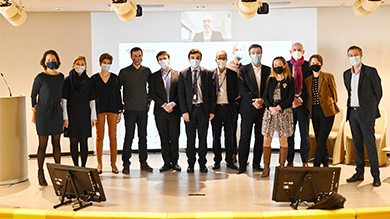The Perspectives 2020 meeting took place on January 30 in France, attended by almost 1,000 of Natixis Investment Managers’ clients.
This event offered an opportunity to find out more about active asset management. Cyril Marie, CFO, Head of Strategy & Corporate Development at Natixis Investment Managers was interviewed by Estelle Castres, Co-Head of the French BDU, in charge of Belux, Geneva, Monaco & Israel.
Natixis Investment Managers‘ multi-affiliate approach is virtually unprecedented on the market. What is the reasoning behind this model?
We chose this model based on an objective analysis of our industry and the role we wanted to play in it.
Like many other mature industries, asset management is split into two models. On the one hand, we have operations where management fees are low relative to the assets under management and where company scale and size are key. This explains why some sector companies players are merging, with an acceleration in this consolidation trend. It mainly involves passive index-tracker type asset management, but other types of strategies are also affected, such as money market management.
At the other end of the spectrum, we have active asset management, which is based on analysis, convictions and complex processes. This approach is more expensive for clients but harbors higher performance potential. It is limited in terms of capacity.
However, these two aspects of our industry should not be pitted against each other: both approaches are required when building investors’ portfolios. Here at Natixis, we have resolutely opted for an active asset management approach to generate alpha for our clients. The only criterion for an investor, and therefore for regulators, is “value for money”.
As an asset manager, the real risk is getting stuck with expensive products that do not deliver the outcomes promised to clients. In Europe, some believe they can escape this trend by acquiring captive distribution networks, but this is only a short-term strategy.
« Here at Natixis, we have resolutely opted for an active asset management approach to generate alpha for our clients. »
Isn’t the active asset management model more demanding?
Opting for active management means choosing performance and relying on our talented staff. Our industry is very transparent, quality through our products’ performance is accessible to everyone at all times. We must be able to attract the most talented staff and retain them by offering the best possible environment to embody their convictions and leverage their expertise.
Our multi-affiliate model offers two advantages.
Firstly, it allows management teams to focus on what they do best i.e. designing high-performance investment strategies and managing their clients’ portfolios. It also safeguards these teams’ entrepreneurial drive as a result of long-term alignment.
Many companies are now trying this path, but the road is long and having sufficient financial resources is not the only requirement.
The multi-affiliate model is taken from the United States, where the asset management industry is very mature. The US accounts for 50% of the world market and we have been present in the country for 20 years. We subsequently developed this model in Europe and are now rolling it out in the Asia Pacific region.
Year after year, we have developed a value proposition that allows us to be competitive and attract teams without having to pay out excessive multiples. It is not enough to just be a shareholder!
During the first interview with a team, we summarize our value proposition in 5 strands:
- We guarantee them independence in their management strategy, and this is a key point.
- Our interests are aligned for the long term, which means that our success and theirs go hand-in-hand.
- We offer the strength of a global distribution platform and the force of a high-quality solutions and portfolio construction team.
- We provide seed money to support their entrepreneurial drive and innovation.
- We also bring an extra level of supervision that allows us to bring all our affiliates up to the same standards.
Natixis Investment Managers has 4,000 employees, including 3,000 within our affiliates and 1,000 cross-affiliate staff. These 1,000 employees deliver the value proposition outlined above, which is also our barrier to entry. These staff provide distribution, marketing, solutions, structuring and fund operations services and supervise these management teams, offering an approach that is the culmination of 20 years of continuous investment.
Of course, other asset managers use a multi-boutique model, but only Natixis Investment Managers has such a global presence, with 23 affiliates, a top-ranking value proposition and more than €900 bn in assets under management.
However, this does not mean that the model is set in stone. In fact, it is constantly being adjusted to address our clients’ needs, changes in the environment and regulation. We have set up a solutions platform, we are strengthening our risk control and governance with the help of a dedicated charter, and we are actively engaged in the fight against climate change.
Your teams are regularly contacted to form fresh partnerships with asset managers of varying sizes. What approach do you take and what is your vision when it comes to industry consolidation?
“Our clients’ trust and our ability to attract new teams are our two greatest sources of pride.”
We have many discussions with several teams who are interested in this venture with us: some are already in the company and are attracted by the entrepreneurial adventure, and some join from outside.
We actively manage our portfolio of affiliates as follows:
- We avoid overlap in our products: this is both a matter of trust with the management teams and an issue of the consistency of our range.
- We do not necessarily want to increase our number of affiliates, but rather we seek to have companies with critical size in their respective sectors and real franchises on key themes, such as fixed income, equities, real estate, global macro, etc.
- We direct the portfolio to address new client needs.
Additionally, we are extremely selective when it comes to considering whether to acquire new boutiques. We firstly check the compatibility of our approaches from a strategic and cultural point of view, and we assess the sustainability of the performance and the long-term vision of the team we are considering integrating.
Can you tell us about any recent acquisitions or stakes?
Two themes have acted as the basis for our recent efforts:
The goal to diversify our equity offering towards growth investment strategies. As a reminder, this investment approach consists of selecting stocks that are relatively expensive but that on the one hand have solid economic fundamentals and on the other hand have the best growth prospects for the coming years.
In 2019, we acquired a minority interest in WCM Investment Management, a California-based US Investment Management firm known for its low-turnover, alpha-generating equity funds. Our partnership with WCM has bolstered our global, emerging markets and US equity offering.
In 2019, we also welcomed on-board one of the best teams on thematic approaches. The team created its own company and brand, Thematics Asset Management, which is now one of our most promising affiliates. They currently manage over €600 m and their AI fund has just been included in the so-called Tibi plan for financing French technology companies.
Real assets. With 8 affiliates and €75 bn in assets under management, we now have a range of products to meet our clients’ growing demand for diversification i.e. private equity, infrastructure, private debt, etc. We are one of the leading generalist asset managers.
With this in mind, MV Credit, a London-based corporate private debt specialist, joined us in 2018 and Vauban Infrastructure Partners, our latest addition to the infrastructure market, was created.
Could you tell us about the contemplated business partnership between Ostrum Asset Management and La Banque Postale Asset Management announced last June?
This is an impressive project that aims to create a European leader in fixed-income and insurance-related asset management with nearly €500 billion in assets under management. It is also an initiative that is perfectly consistent with the market structure described above: in fixed-income and insurance-related asset management, size and operational efficiency are essential to remain competitive.
This contemplated combination is set to be first and foremost a major success for the Ostrum teams, whose asset management expertise and high-quality IT and operational management platform have impressed La Banque Postale Asset Management. It is a resolutely proactive development initiative that aims to create a platform with the best standards in the market open to all asset managers serving insurance clients.
Given the persistently low interest-rate environment, this is an innovative and extremely positive development for both entities.
ABOUT NATIXIS INVESTMENT MANAGERS
Natixis Investment Managers serves financial professionals with more insightful ways to construct portfolios. Powered by the expertise of more than 20 specialized investment managers globally, we apply Active Thinking® to deliver proactive solutions that help clients pursue better outcomes in all markets. Natixis ranks among the world’s largest asset management firms1 (USD 1,048.4 billion AUM2).
Natixis Investment Managers’ distribution and service groups include Natixis Distribution, L.P. (a limited purpose US broker-dealer and the distributor of various US registered investment companies for which advisory services are provided by affiliated firms of Natixis Investment Managers), Natixis Investment Managers S.A. (Luxembourg), Natixis Investment Managers International (France), and their affiliated distribution and service entities in Europe and Asia.
1 Cerulli Quantitative Update: Global Markets 2019 ranked Natixis Investment Managers as the 17th largest asset manager in the world based on assets under management as of December 31, 2018.
2 Net asset value as of December 31, 2019. Assets under management (“AUM”), as reported, may include notional assets, assets serviced, gross assets and other types of non-regulatory AUM.














